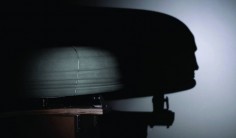Pablo Garcia
Profilograph (after Dürer)
source: highlike
Work: In Vier Bücher von Menschlicher Proportion (Four Books on Human Proportion) (1528), Albrecht Dürer exhaustively examines variations of human form. Not as Vitruvius’ depiction of ideal human measurements, but as a full range of proportional possibilities. This physiognomic treatise establishes the basic parameters for drawing the human face and figure, such as relationships between the eye, nose, mouth, and chin. Over dozens of pages, Dürer shows an incredible variety of male and female figures and facial profiles, drawn by hand but made with a precise mechanical approach to geometric variation. The six facial profiles Dürer presents early in the treatise are the basis for this machine. Using a process I call Profilography—tracing and extruding a series of sequential contours or profiles—the six faces become a continuous facial profile. Slicing through the extrusion yields new faces, derived from Dürer but absent from his analog treatise. After making the form into a closed loop, I 3D printed the form and mounted it onto a motor-driven spindle. As the piece spins, a light casting a shadow along the profile edge animates the transforming faces. Dürer’s early experiment into parametric transformations arrives at its 21st century digitally-produced conclusion.
Photographer: Pablo Garcia
.
.
.
.
.
.
.
source: thisiscolossal
The Profilograph is a bizarre device created by Chicago artist Pablo Garcia based on a series of four books written in 1528 by German artist Albrecht Dürer that examine the geometry of the male profile through carefully documented illustrations. The device transforms a series of Dürer’s drawings into a contiguous 3D extrusion that rotates on a circular spindle causing a shadow that morphs between each profile. The machine was designed in 2008 for an exhibition at the University of Michigan. You can learn more about the Profilograph here, and if you liked this also check out Kumi Yamashita’s origami profiles.
.
.
.
.
.
.
.
source: movimento31
Vejam que lindo esse vídeo sobre o estudo das proporções do rosto humano. Profilograph é uma instalação artística feita por Pablo Garcia, de Chicago, inspirada na obra do pintor, ilustrador e matemático alemão Albrecht Dürer.
.
.
.
.
.
.
.
source: dobask
Priznávame, titulok tohto článku je trochu tajomný a ničnehovoriaci. Lenže presne také je aj samotné zariadenie, o ktorom článok pojednáva. Volá sa Profilograf. Navrhol a vytvoril ho Pablo Garcia, umelec z Chicaga, na základe štyroch kníh od nemeckého umelca Albrechta Dürera z roku 1528, ktoré sa zaoberajú geometriou ľudského profilu. Toto zriadenie mení Dürerové kresby v realitu. Viac sa dozviete z obrázkov a videa.
.
.
.
.
.
.
.
source: fastcodesign
In 1528, Albrecht Dürer published Vier Bücher von Menschlicher Proportion, or Four Books on Human Proportion, a rigorous catalog of the human form in all its splendid variety. Nearly 500 years later, Pablo Garcia used cutting-edge technologies to combine six of Dürer’s profiles into a single object–an extruded, three-dimensional wheel. Set on a spinning motor and illuminated to create a shadow of fluidly transforming faces, Garcia’s Profilograph is a novel ode to the German master as it could only exist centuries after his lifetime.
The seeds for the project were planted nearly a decade ago, in 2004. Garcia had just left graduate school, where he’d been part of the first class to learn the wonders of the then brand new CNC router. “Flipping through a woodworking catalog, I saw a section on router bits for making moldings,” he says. “Looking at dozens of profile shapes, I had a thought: Why would anyone want to buy all these tools, when one day a CNC will be able to make any profile you want?”
That question served as the impetus for a project that would eventually encompass a slew of new technologies and techniques. First, Garcia experimented with CAD software, making 3-D extrusions of simple shapes. Eventually, he realized that he could create blended extrusions, and with a piece of scrap foam he created an object that seamlessly stretched his own profile into his wife’s. “Purely by chance, I put a ruler down next to it, and the light cast a thin shadow line across the piece. The shadow revealed a new profile, one that was blended between the two ends,” he remembers.
In 2008, as the Muschenheim fellow in architecture at the University of Michigan, Garcia found access to a far greater range of materials, and along with the help of people in the 3-D printing and metals labs, he realized his novel extrusions in some more ambitious ways. First, he tapped Dürer’s study for six distinct profiles, which he then extruded into a single form, joined end to end, and fabricated with a 3-D printer. In another experiment, he cast Muybridge’s famous frames of a galloping horse as a single bronze form.
“In one sense, these projects are about the process that requires both understanding of history and contemporary methods, of both hand crafting and cutting-edge computing, and about how to move between them,” Garcia says. “Looking at it again, I realize how much of it is a Frankenstein’s monster of techniques and media and time periods.”
But while the artist’s excitement came from exploring new processes and pushing up against their limitations, Garcia doesn’t see the works merely as “lessons in making.” “As finished pieces,” he says, “I hope they perform a little magic.” You have to imagine Dürer would think so.


